Article
Design meets Strategy
Creating business value by merging design and strategy
In today's business landscape, design has become a crucial factor in driving company success. This article explores the added value that design brings to strategy work and the impact that strategic design can create for a company.

Introduction
The more experience I gain, the more I find myself referring simply to design. The design field has become fragmented with practices that are either overly specific or sometimes too broad, including Graphic Design, Visual Design, UI Design, UX Design, UX Research, CX Design, CX Research, Product Design, Concept Design, Service Design, Content Design, Marketing Design, Business Design, Strategic Design, and more. In this article, I'll refer to all these activities collectively as design. I admit, this topic can be challenging, but let's dive in and see what we uncover.
What is Design?
A brief introduction: I hold a Bachelor's degree in Arts & Design and a Master's degree in Service Design, with over 15 years of experience in concepting, designing, and productizing digital services across various industries and platforms. In recent years, my focus has shifted toward driving business results and achieving strategic outcomes through design. But the thing is, the deeper I dive into the world of design, the more I find myself asking – what exactly is design?
Design can be challenging for people to grasp because, unlike physics or math, it's not an exact science. People also perceive design differently – some view it as purely creative and aesthetic, while others see it as pragmatic and functional. One thing is certain: design is user-centric.
Here's my take on what design is: in essence, design is a user-centric problem-solving discipline that draws on approaches, methods, and processes from fields like art, engineering, ergonomics, manufacturing, psychology, finance, marketing and branding, among others. It's pragmatic, relying heavily on processes and methods to frame questions and find insights. While design can be highly structured, it's also inherently open-minded, embracing a certain vagueness that encourages exploration. No wonder design can seem confusing and hard to define.
One thing that has recently puzzled me is the separation of design and marketing. Both require a creative mindset, and marketing wouldn't exist without design, as many marketing activities are inherently design-driven. So why have design and marketing diverged? My observation is that modern design has shifted away from creativity, focusing more on functionality, with generic designs produced through design systems rather than tailored, creative solutions. It seems that creativity has been increasingly left to marketing alone.
Imagine a linear scale, with Aesthetics on the far left and Functionality on the far right. Art, as a practice, sits on the far left because it exists to express, while Engineering is on the far right, as it exists to build. In my mind, design falls somewhere between these two seemingly opposing forces. Design acts as the glue between the warm and chaotic art, and the cold, calculated precision of engineering. It's no surprise that designers often advocate for breaking down silos and fostering cross-departmental collaboration.
Seasoned designer and mobile design pioneer Luke Wroblewski encapsulates what design is mostly all about:
“Obvious always wins.”
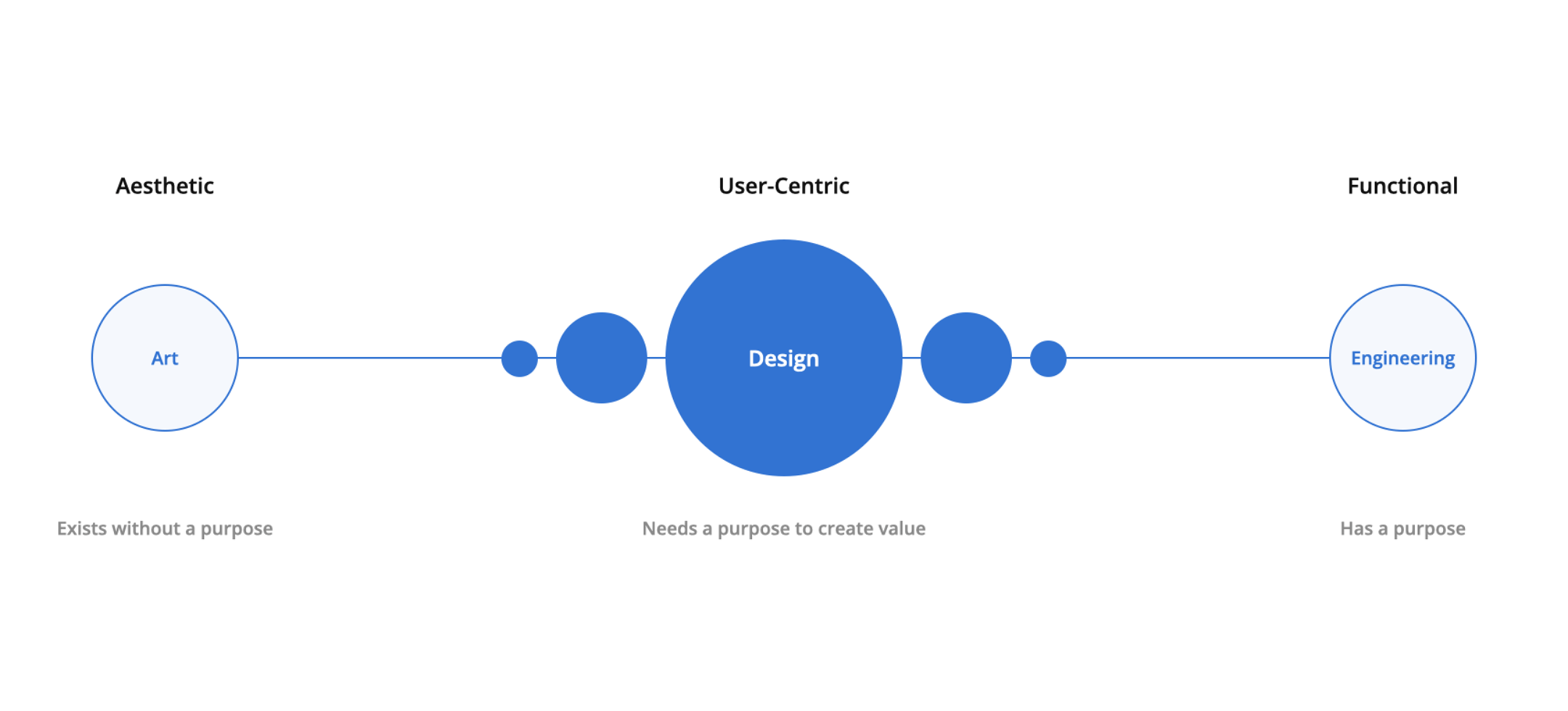
Somewhat generalized, art is subjective, while design strives to be as objective as possible. Pure functionality, on its own, is simply engineering.
What is Strategy?
Another complex topic is strategy – what exactly is it? In the book Playing to Win, Alan Lafley and Roger Martin describe strategy simply as a choice. I would add that strategy involves deciding which approach to take to achieve a desired outcome. Strategy is also about leadership and deciding what not to do, as American economist and strategy expert Michael Porter stated:
“The essence of strategy is choosing what not to do.”
For example, if a company aims to differentiate itself from competitors, it needs a strategy to achieve this objective. Often, reaching an ambitious or long-term objective requires accomplishing multiple short-term goals along the way. A strategy typically outlines a plan defining the path and means to achieve these goals. Strategy execution is measured by tracking Key Performance Indicators (KPIs) or Objectives and Key Results (OKRs) to assess if the strategy is progressing as intended. A good strategy is SMART – specific, measurable, attainable, relevant and time-bound.
Predicting the future, or scenario planning, is a vital part of strategy – and it's something designers excel at. In design schools, we're taught to envision and create multiple versions of an outcome. Typically, designers start by mapping the current state to build understanding and empathy, then propose a highly creative version. This "wild" version may be unrealistic but often sparks inspiration among stakeholders for what the future could look like. Following this, designers create one or two more grounded versions, which are less ambitious but more realistic, still offering a significant improvement over the current state. This approach closely resembles scenario planning in strategy, though in strategy, a risk scenario is also considered. Since design is user-centric and designers often focus on trends, they naturally seek ways to provide innovative, delightful solutions for users. This may lead to differentiation from competitors, providing competitive advantage, or even open new market opportunities for the company.
Sometimes, company leaders are so distanced from their own offerings and customers that the strategy they create becomes overly high-level, making it difficult for employees to understand and execute – and, ultimately, hard to succeed.
Steve Jobs famously said:
“You should always start from your customer.”
I firmly believe that strategy work should also be customer-centric. It makes perfect sense: the company is creating offerings for its customers, so why not listen to the very people it exists to serve? Yet, I've seen firsthand that this is not always the case.
One confusing aspect of strategy is that it exists at various business levels: visionary, strategic, tactical and operational. It may seem odd to create a strategy for operational work, which is the "ground level" of business. However, to ensure daily work is as productive and enjoyable as possible for employees, there needs to be a well-defined strategy for operational execution. Additionally, each business line should have its own strategy, and individual products should have unique product strategies. The main differences among these strategies are typically scope and time span. A product strategy is more detailed, includes specific actions, and has shorter-term targets compared to the strategy for an entire business line.
I'd argue that strategy development always involves a framework – such as the Strategy Choice Cascade, Blue Ocean Strategy, or the 3 Horizons model – to help define the strategic vision, explore scenarios, plan priorities, set objectives and responsibilities, and measure and evaluate outcomes to track execution success. The greatest benefits of integrating design into strategy work are bringing creativity to shape the vision and drive value creation, understanding customers and the competitive landscape, and identifying points of differentiation to achieve competitive advantage. Strategy projects could benefit from utilizing design more and involving designers directly in strategy development.

An example of a simple strategy framework I sometimes use is an adapted combination of the Double Diamond and the Creative Briefing processes. The model illustrates how creative work typically divides into two phases: the opportunity (or problem) space, where discovery and analysis are intertwined, and the scenario (or solution) space, where the defining and concepting are combined. At the intersection of these two spaces, a "Eureka!" moment often occurs, clarifying the vision of the desired outcome.
It's interesting to see how AI can be applied in strategy. In theory, AI's ability to analyze vast datasets and identify complex patterns allows companies to forecast future scenarios, understand consumer behavior, and predict market trends. This creates more accurate and realistic strategic scenarios, helping companies make informed decisions about which direction to follow.
What is Strategic Design?
To add another layer of complexity, let's examine the combination of design and strategy into a single practice. I can speak from first-hand experience: a few years ago, I had the opportunity to create a design strategy for a digital agency as my master's thesis – a fascinating journey into business and strategic design. The end result was both a study and a strategic document that guides the integration of design thinking and user-centric approaches into the company's culture and operations, with the goal of maturing its design practices and contributing to its growth and success.
Crafting the design strategy presented a unique challenge, as there were no clear blueprints or guidelines to follow. The strategy could have been more tactical, focusing on defining the brand identity and design language in alignment with the company's strategy. However, since the company was a digital agency with an already strong design language and brand identity, the work concentrated more on the company and business side, resulting in a higher-level, more holistic approach than a typical design strategy might entail. It's also quite different to define the business and offerings for a consultancy than it is for an in-house product portfolio. Just as every company strategy is unique, the same applies to design strategy: each one is tailored to its specific environment.
The design strategy emphasizes the importance of achieving design maturity by aligning the design approach with the business plan, corporate culture, brand development, service offerings, and processes. A user-centric design approach was integrated into the service offerings, while the business lines were defined and organized through portfolio management. Design is essential for bringing abstract concepts, like digital portfolios, to life. Another key outcome of the design strategy was the design roadmap, which underscored the immediate need for a comprehensive business plan and clear brand management.
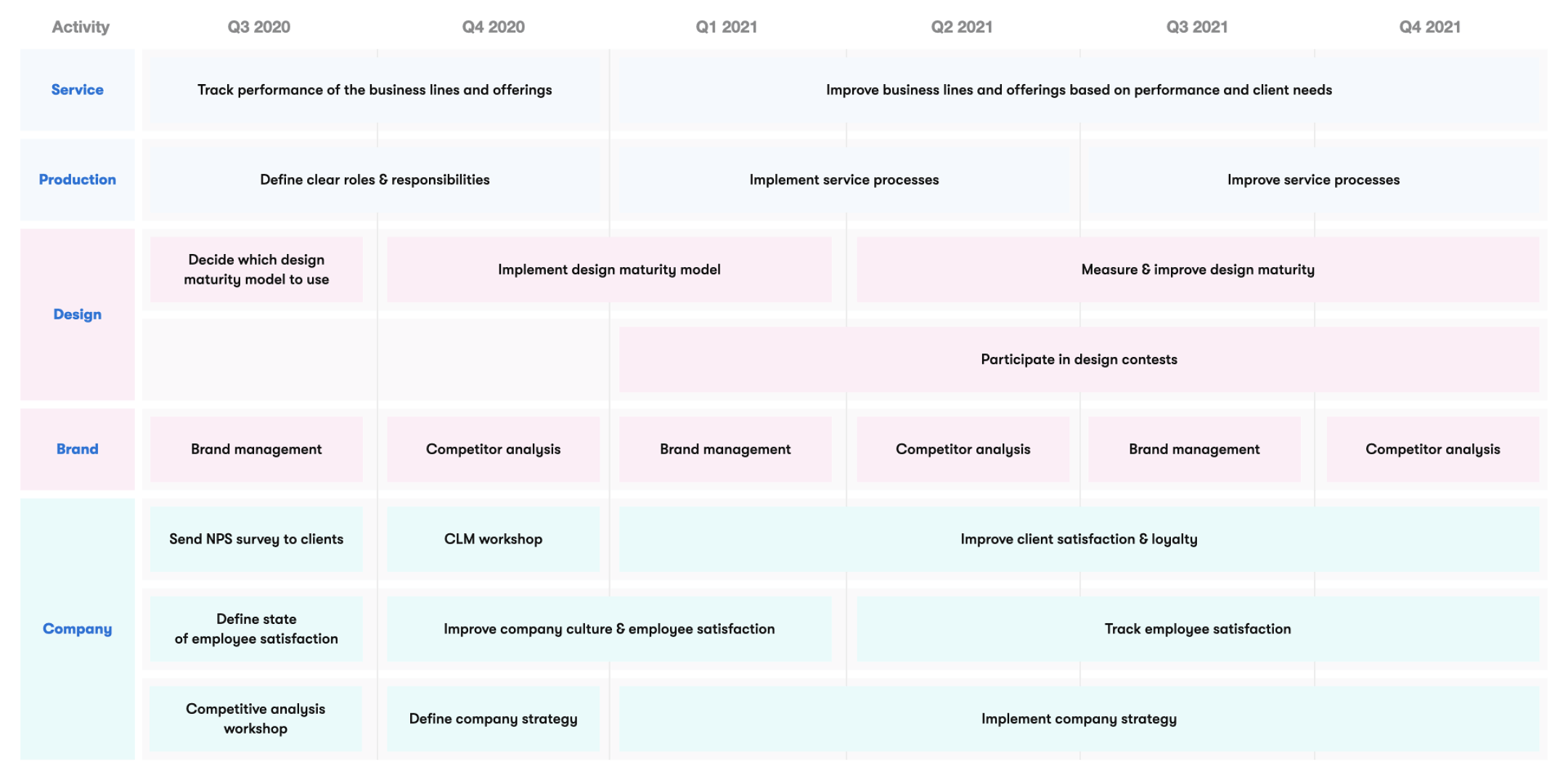
The roadmap defined in the Design Strategy focuses on improving service offerings and production processes, elevating overall brand and design maturity, and developing company culture and employee satisfaction.
For any strategy to succeed, it requires management support – this is especially true for design strategy. Fortunately, I had the CEO's backing, and he commended the thoroughness and strategic depth of the work, noting that the design strategy will be crucial in guiding the company toward its vision of becoming a leading full-service digital agency.
Value of Design
Even today, some business leaders don't fully recognize the value of design, as its direct impact can be difficult to measure. However, companies that invest in design have an undeniable advantage over competitors in areas like brand recognition, service quality, customer experience, and even revenue or stock performance. A well-known example is Apple, which as an underdog outperformed industry leader Nokia. While Nokia focused primarily on device performance, manufacturing optimization and functionality, Apple invested in the entire ecosystem, customer experience and quality.

The 2015 study by the Design Management Institute (DMI) shows that the market index value of companies leveraging design in business was 211 % higher compared to the S&P 500 market index.
Design is also intended for solving or addressing wicked problems – issues that are difficult or even impossible to solve due to incomplete, contradictory, and evolving requirements that are often hard to identify. A wicked problem has no single solution; it refers to a challenge that cannot be fully resolved. Another definition describes it as "a problem whose social complexity means that it has no determinable stopping point". Additionally, due to complex interdependencies, solving one aspect of a wicked problem may reveal or create other issues. Design offers methods to recognize and address wicked problems, but it often requires "slow thinking" and a willingness to compromise.
Design plays an essential role in building a brand, which is a blend of image, experience, and reputation of a company. Ultimately, a brand is defined by how people perceive, experience and talk about it, rather than how the company wishes to be perceived. Branding is a discipline through which a company maintains its brand presence via media appearances, PR statements, quality offerings with appealing design, and exceptional customer service. The brand is often the company's most valuable intangible asset – consider Tesla and Coca-Cola as examples.
Design is fundamental in defining brand identity and developing brand assets, from visual elements like logos, typefaces, icons, and imagery to digital presence (websites and apps) and non-visual assets such as slogans, value propositions, tone of voice, company story & culture, positioning, values, and mission statements. Brand identity is the main influence on how the company wishes to be perceived by the public, and these activities are prime opportunities for applying strategic design.
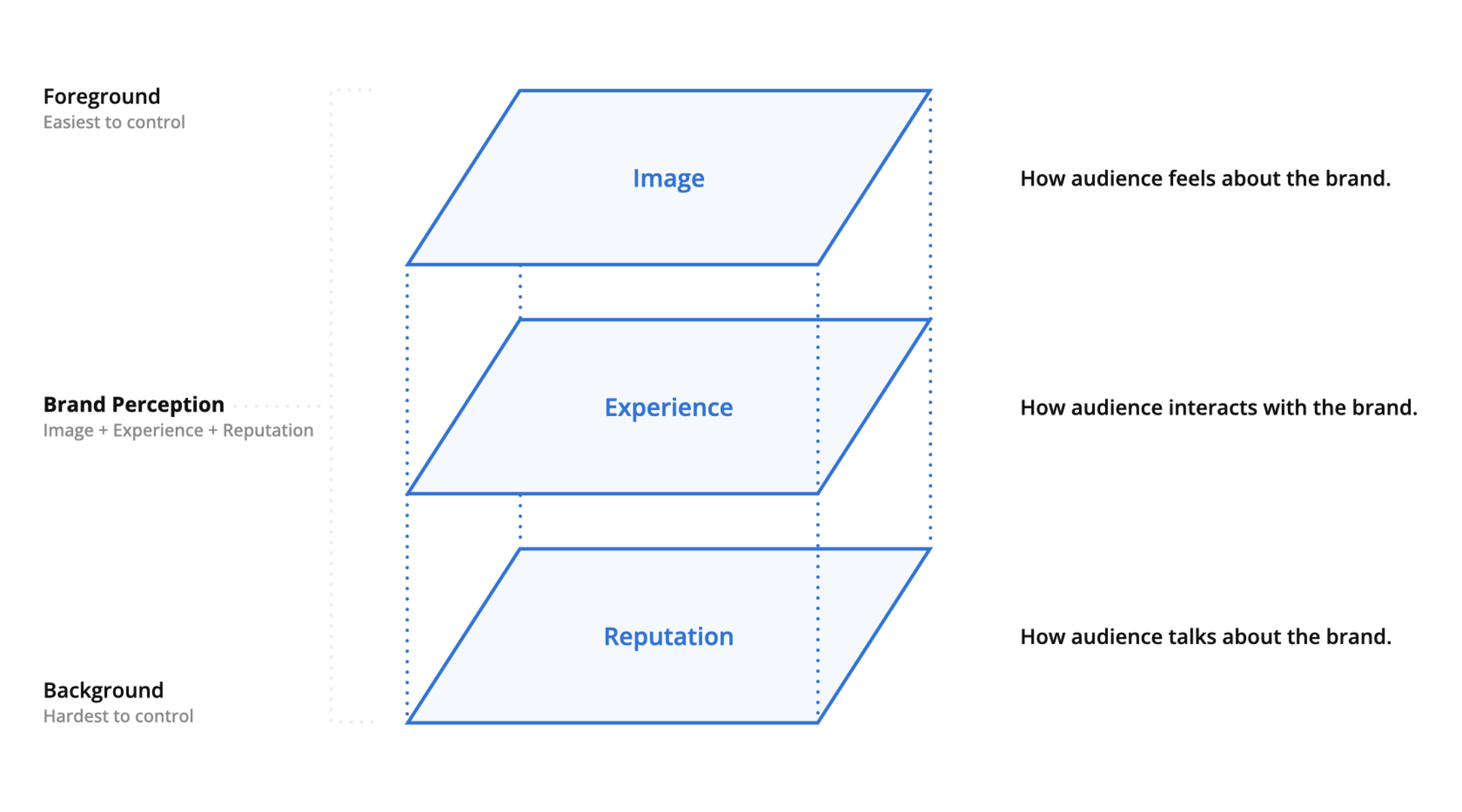
Image, experience, and reputation together define how the brand is truly perceived by the audience – such as customers, rivals, and the media.
A company must have strong offerings to survive, but branding – through design – creates a competitive advantage that elevates a company from average to exceptional. A strong brand allows companies to sell their offerings at a higher price than their rivals, a concept known as price premium, which can be achieved by developing a strong brand. Related to offerings is brand experience, which refers to how people engage and interact with the brand. Interactions, such as the quality of customer service and the offerings themselves (whether physical products or digital services), shape this experience. While products and services are naturally designed, so too are service scenarios, such as interactions with customer and delivery services, and sales. Design is the enabler that creates consistent brand experiences, which contribute to a positive brand reputation.
“Design makes brands strong and companies successful.”
– German Design Council
In strategic design, I often rely on Visual Portfolio Management, which is based on the Simplified Product Portfolio Matrix. Visual Portfolio Management exemplifies strategic design at its finest, as it's where design truly flourishes. By visually categorizing offerings – by type, similarity, market, segment, sector, or pricing – the portfolio takes shape, allowing for quick identification of areas that may be overly crowded or underrepresented. This process can lead to the definition of product families or even new business lines. It's the same principle Steve Jobs used when he drew his famous four-quadrant matrix to convey Apple's strategic vision. I encourage every designer to visualize their company's offerings to gain a deeper understanding of what the company provides to its customers and to generate ideas on how to organize the portfolio more effectively.
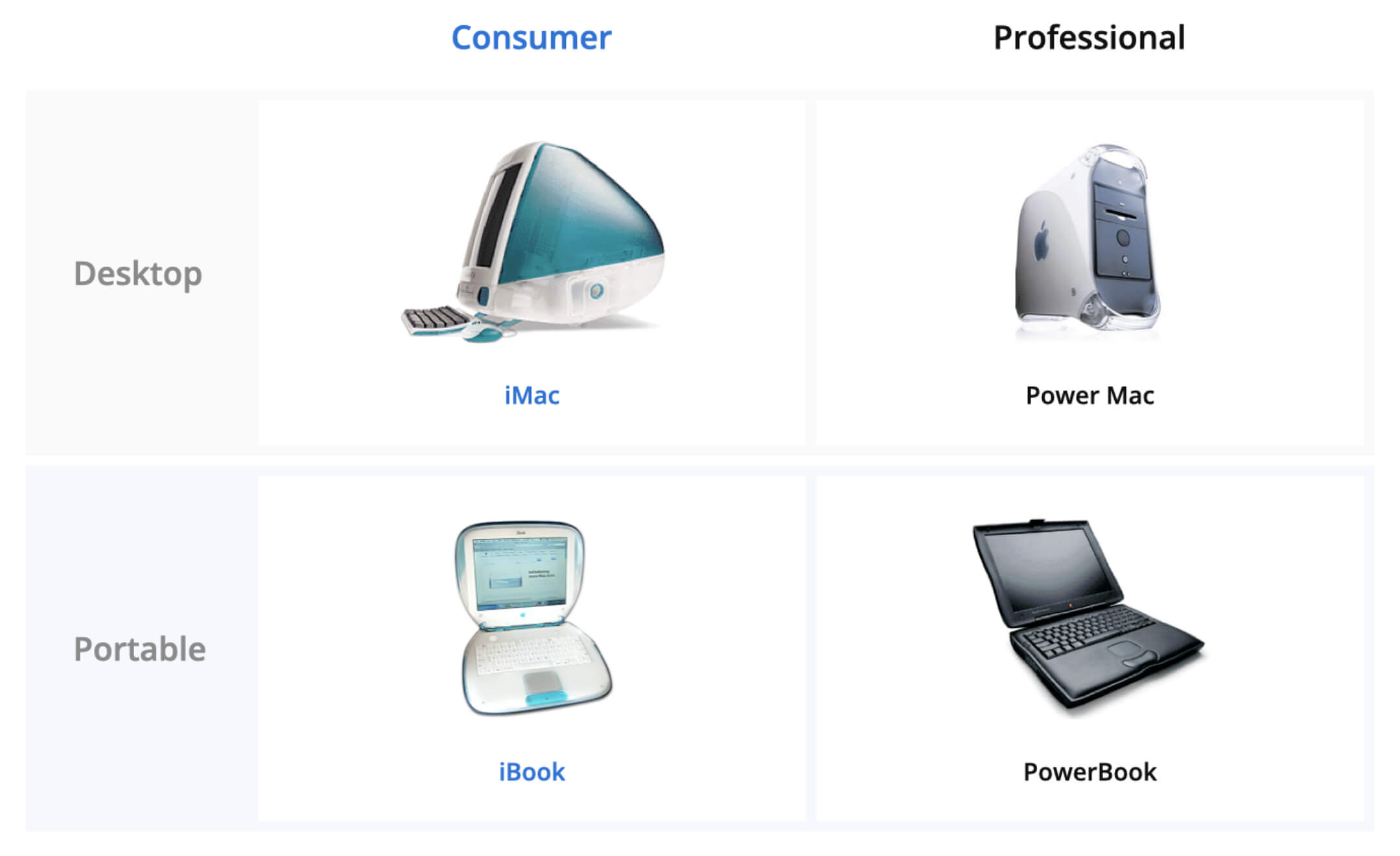
When returning to Apple in 1997, Steve Jobs terminated most product lines and focused only on a few key products for specific segments. This strategic move was later credited with saving Apple from near-certain bankruptcy.
Another area where design adds significant value is in managing customership. Every company has a vision of how customership should evolve over time. Design plays a key role in creating a friction-free journey for the customer, making the relationship enjoyable and encouraging long-term loyalty. This approach benefits both the customer, who receives a better service and experience, and the company, which gains greater value from its customers. It's a true win-win for value creation, with design as the enabler.
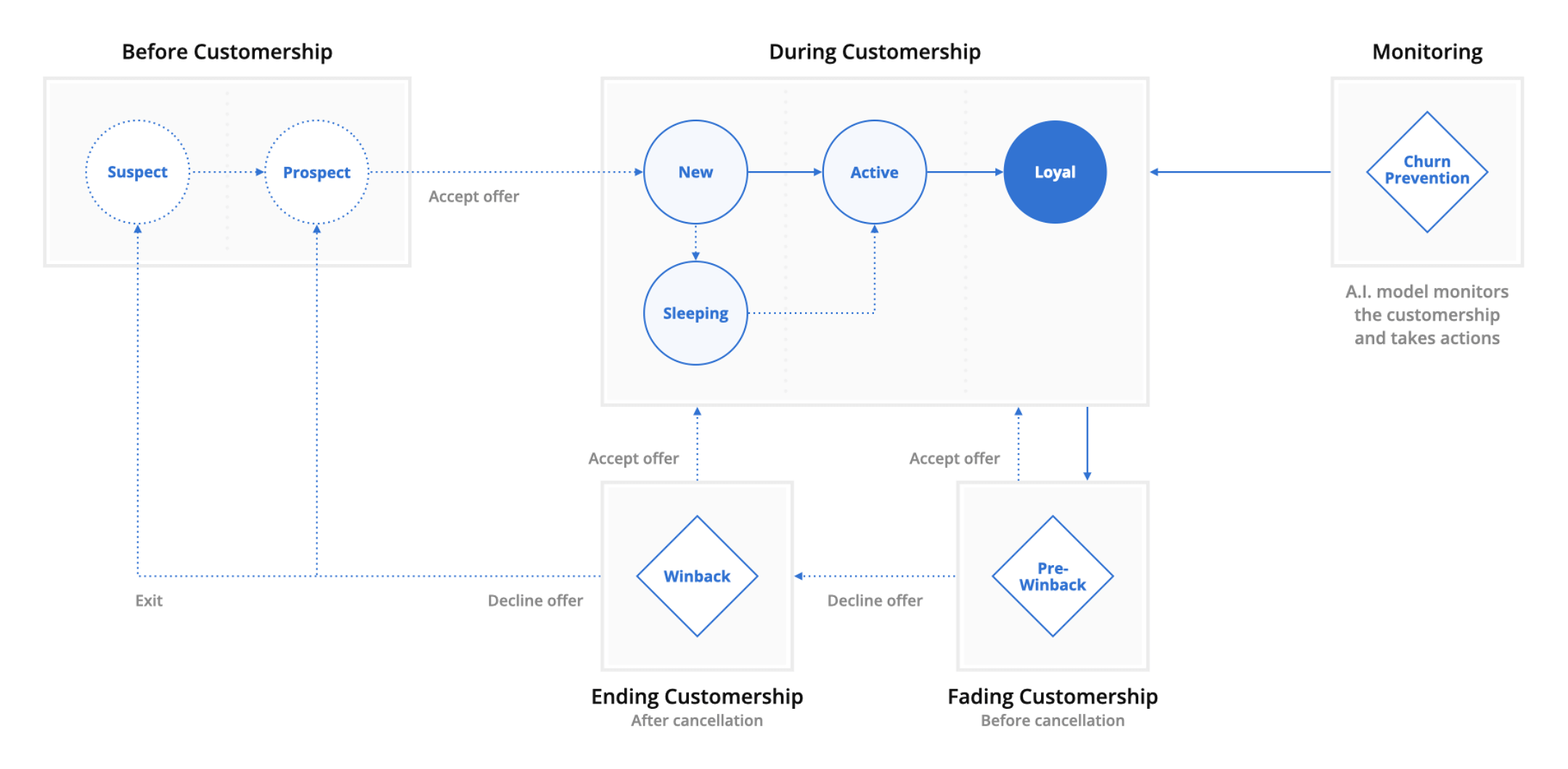
An example of a visualized, end-to-end overview of the customer lifecycle, from suspect to loyal customer, and eventually back to the prospect pool via churn. Each customer stage was carefully outlined in the strategic document, providing solutions to enhance experiences and elevate customers to higher engagement levels.
Measuring Design Impact
As mentioned above, measuring performance is a crucial aspect of strategy, and measuring design impact is not as difficult as it may seem. The perception of design measurement as vague often stems from attempts to evaluate the success of art or aesthetics, which can indeed be challenging. Art primarily serves the purposes of aesthetics and expression. It's often used for self-expression and to reflect the surrounding world. Art can make a statement and tell a story, but its communication is mostly one-way, leaving room for the viewer to interpret the work, providing an intellectual challenge to grasp the artist's intended message. Consequently, the artistic process is subjective. Art occupies the aesthetic end of the spectrum, as it can exist without a defined purpose.
On the other hand, design's primary purpose is to align requirements with needs, essentially ensuring that supply and demand match. This makes the design process objective. In design, there's little room for interpretation; functionality is as important – if not more so – than aesthetics. In the digital world, design is almost always interactive, making communication two-way. Design balances aesthetics and functionality, as it must serve a purpose. Therefore, measuring design impact focuses more on assessing the effect of changes rather than merely evaluating the aesthetic appeal of the outcome.
Design impact is measurable as long as there is a clear need for design or a specific reason for change. If design work is undertaken without clear objectives or merely for fun, assessing its success is difficult, and it may result in little positive impact. In my previous article, Designing to Differentiate, I discussed common methods for measuring design in digital environments. However, I didn't mention the typical business metrics that also apply when evaluating design success or, more specifically, the impact of design changes.
Business Metrics
- Sales by value and units (incl. upsell and cross-sell)
- Adoption, engagement, retention and churn rates
- Customer base size and new customer acquisition
- Customer lifetime as value and tenure
- Customer support and self-care usage
- Brand awareness and purchase intent
- Market capitalization and market share
Design's role is to create value, while the business side focuses more on capturing value. They complement each other to form a complete picture. The last two metrics are considered brand metrics, but then again, brand is business – it's the public representation of the company. In my view, a modern leader or CEO must understand branding, as it's a crucial aspect of the company. In small companies without dedicated Brand Managers or Marketing Managers, the CEO is responsible for brand development. Branding is such an interesting and broad topic that I plan to explore it further in another article.
Summary
In summary, strategic design aligns design work with the company's brand and core strategies, such as its mission, values, and vision. Although challenging, aligning design with strategy is essential for building a successful and competitive business in today's world. By securing management support, maintaining an open mind, and integrating strategy frameworks with design methods, it can be seen how design can add unforeseen value to business development and strategic planning. In the end strategic design is about maximizing customer satisfaction and minimizing business risks.
My master's thesis mentor, a senior consultant at Deloitte, described strategic design as the urge to avoid jumping to conclusions. As designers and humans, it's natural for us to quickly start crafting solutions to problems. In strategic design, however, the opportunity (or problem) space is approached with an open mind from multiple angles, examining themes from various perspectives. The designer must be willing to spend an uncomfortable amount of time in this space to ensure all important information and valuable insights have been gathered before ideating or suggesting any solutions.
Merging design and strategy is a fascinating and expansive topic to explore. Although the design industry is currently in turmoil, I strongly believe that strategic designers will be in high demand in the near future. This is the first of several articles I'll be writing on the topic – enjoy, and stay tuned! ▪